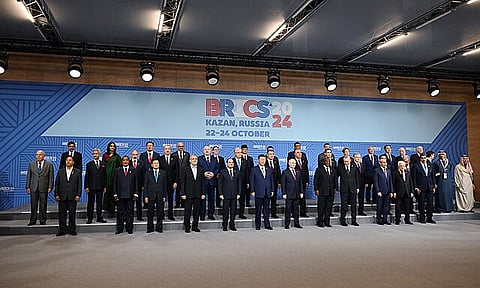

As the world grapples with economic uncertainty and the looming threat of a modern trade war, the BRICS bloc finds itself at a pivotal moment. The recent return of Donald Trump to office has marked a renewed shift in U.S. foreign economic policy one that leans toward isolationism and protectionism. Trump's swift imposition of new export tariffs and withdrawal from key multilateral commitments has rattled global markets and signaled a more confrontational stance on trade.
Despite its aggressive posture, the United States remains the largest stakeholder in global financial institutions such as the World Bank. However, cracks in the current international financial system are offering an opening for alternative frameworks, most notably, those championed by BRICS to assert influence and provide a counterweight to Western-dominated governance structures.
A study spanning 81 developing countries from 1986 to 2016 highlighted the limited effectiveness of International Monetary Fund (IMF) conditional loans, prompting many states to seek alternative models. This vacuum contributed to the rise of minilateral coalitions like the G77 and eventually, BRICS itself anchored by Brazil, Russia, India, China, and South Africa. Formed in the wake of these economic shifts, BRICS has sought to reform global financial governance in response to a post-war Western narrative.
The 2008 global financial crisis served as a turning point. At their first summit, BRICS leaders called for reforms to international financial institutions to reflect changes in the global economy. By 2023, the bloc had expanded to include six more countries; Argentina, Egypt, Ethiopia, Iran, Saudi Arabia, and the United Arab Emirates solidifying what is now known as “BRICS+.”
The expansion of BRICS has sparked debate among analysts. While some remain cautious, others see BRICS+ as a transformative force in global geopolitics and economics. The bloc now represents 45 percent of the global population, over 35 percent of global GDP by purchasing power parity, and nearly 30 percent of the world’s oil production. With a growing network of intergovernmental partnerships, BRICS has laid the foundation for a new model of global cooperation.
Among its major achievements are the Contingent Reserve Arrangement (CRA), launched in 2014 with an initial fund of $100 billion to manage liquidity pressures, and the New Development Bank (NDB), which began in 2015 with a starting capitalization of $50 billion. These institutions have allowed BRICS to pursue networked minilateralism, forming cross-border working groups and partnerships across sectors such as energy, health, climate change, technology transfer, and sustainable development.
The bloc's long-term goal is to challenge Western-led economic institutions and reduce dependence on the U.S. dollar. Some experts have even characterized the expansion of BRICS as a milestone in building a more equitable international system. Still, the broader implications for the global order remain uncertain. Key questions persist: Will BRICS+ simply drift away from Western influence, or actively oppose it? Could this lead to deeper divisions in bodies like the G20 and the United Nations?
Growing friction between China and the United States along with Trump’s antagonistic stance on BRICS lends weight to the latter scenario. Yet, internal dynamics complicate the narrative. India, for example, has fostered closer economic and strategic ties with the U.S. Recent talks between Trump and Indian Prime Minister Narendra Modi produced the "US–India COMPACT," aiming to double bilateral trade to $500 billion by 2030 and reinforce cooperation through platforms like the QUAD.
Despite these divergent paths, BRICS remains a vital platform for South-South cooperation, with the shared goal of advancing the financial and political interests of developing nations. Its influence in the non-Western world should not be underestimated.
Several structural advantages reinforce BRICS’ potential. First, geographic proximity and shared development priorities offer opportunities for deeper intra-bloc trade. Between 2001 and 2021, BRICS’ exports surged from $493.9 billion to $4.65 trillion. The expanded bloc now accounts for nearly 40 percent of global oil output and one-quarter of global GDP.
Second, BRICS’ flexible institutional framework has proven attractive to new members. Unlike supranational organizations like the IMF or WTO, BRICS functions as a state-led initiative with limited centralization, emphasizing summit diplomacy over rigid bureaucracy. Its openness to expansion has drawn in resource-rich and fast-growing countries; as of the last summit in Kazan, 34 nations including Indonesia, Bangladesh, Senegal, and Vietnam had formally applied to join.
Third, while progress has been measured, the NDB has achieved notable milestones, including a successful membership expansion, favorable credit ratings, and the issuance of renminbi-denominated bonds. Its General Strategy for 2022–2026 outlines a commitment to helping members meet international targets under the Sustainable Development Goals (SDGs) and the Paris Agreement, while also broadening its focus to key sectors such as energy, transport, ICT, and tourism.
In an effort to further assess these dynamics, the Carnegie Endowment’s Global Order and Institutions (GOI) Program recently launched a comprehensive initiative on BRICS Expansion. The project aims to understand the bloc’s motivations, areas of alignment and divergence among members, and the broader implications for global governance.
As part of this effort, Carnegie solicited commentaries from experts across 17 nations including original BRICS members, recent additions, and aspirant countries like Nigeria, Vietnam, and Turkey. The findings suggest that countries are turning to BRICS for varied reasons: to forge a more balanced global order, to safeguard neutrality amid geopolitical turbulence, or to pursue economic systems insulated from Western sanctions.
Ultimately, the future of BRICS will hinge on two key variables: the extent to which member countries can align around a common vision, and the willingness of Western powers particularly the United States to adapt to a more pluralistic international landscape. As Trump’s second term redefines U.S. engagement with global institutions, the question is not only how BRICS will evolve but whether it will emerge as a rival, or a reluctant partner, in a changing world order.